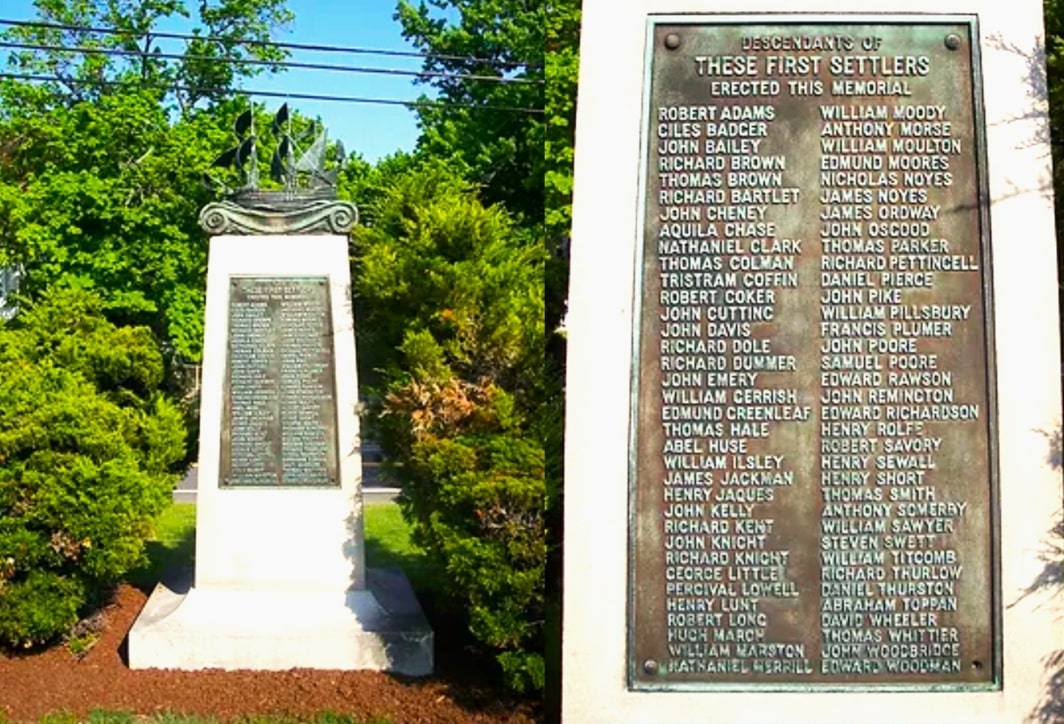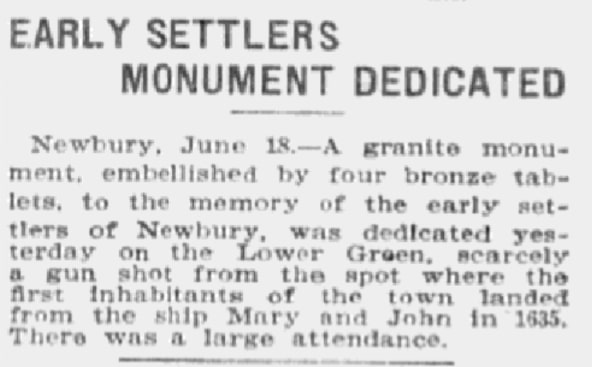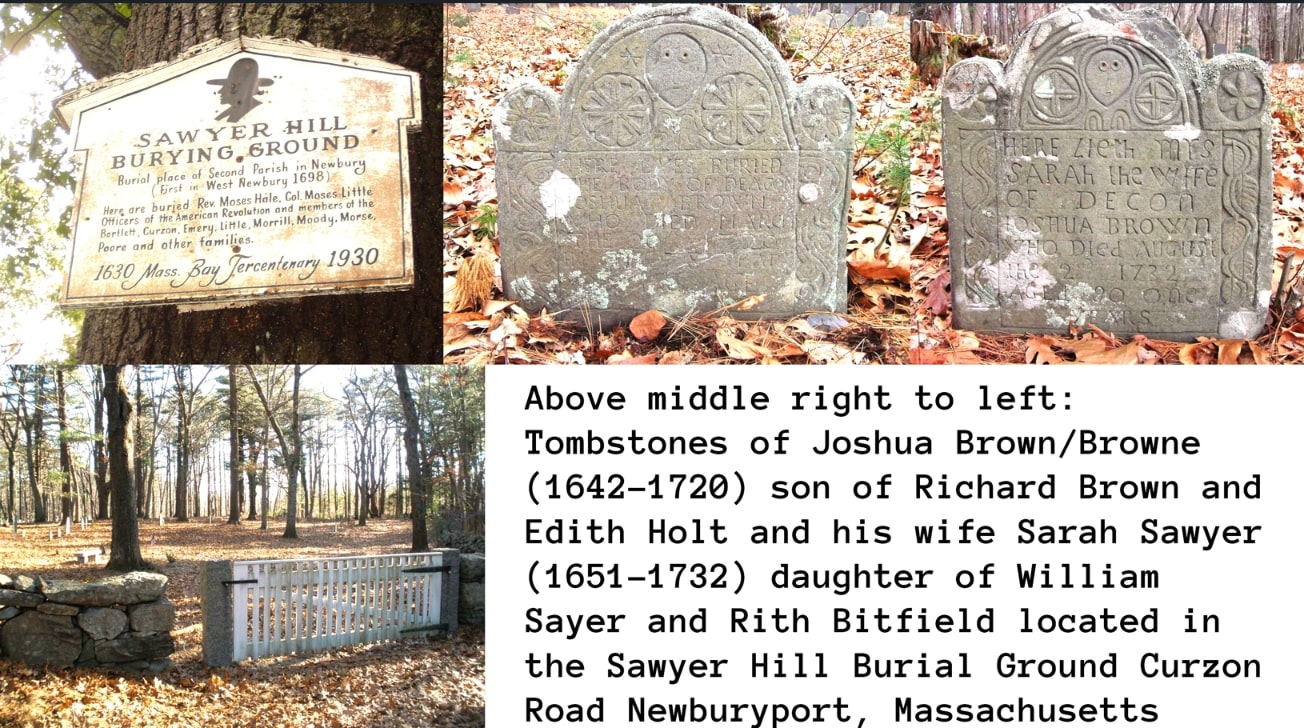Introduction: In this article, Melissa Davenport Berry provides more stories about out-of-wedlock births in colonial America, focusing on Newbury, Massachusetts. Melissa is a genealogist who has a blog, AnceStory Archives, and a Facebook group, New England Family Genealogy and History.
Today I resume my series on the paternity dramas of Colonial New England. The star subjects in this story are from Newbury, a town in Essex County, Massachusetts, which had a plethora of fornication cases with habitual offenders. So, sit back and grab the popcorn.

The First Settlers Monument was dedicated in 1905, as reported by the Boston Journal.

This article reported:
A granite monument embellished by four bronze tablets, to the memory of the early settlers of Newbury, was dedicated yesterday [18 June 1905] on the Lower Green, scarcely a gun shot from the spot where the first inhabitants of the town landed from the ship Mary and John in 1635. There was a large attendance.
Some of the colonial paternity court cases are listed in Melinde Lutz Sanborn’s book Lost Babes: Fornication Abstracts from Court Records, Essex County, Massachusetts, 1692-1745, and most of the original documents are on the FamilySearch site Court Records, 1686-1726.
Many subjects and their kin can be found in Vital Records of Newbury and listed on the above monument of Newbury first settlers. I would also like to thank Bethany Groff, curator of the Museum of Old Newbury, for her assistance.
A Newbury Double Header for Cousins!
On 25 March 1701, Ruth Sawyer (daughter of John Sawyer and Sarah Poore) accused her first cousin Tristram Browne (son of Joshua Browne and Sarah Sawyer) of fathering her son Benjamin Sawyer, born 6 January 1700.

According to the court filings, Ruth confessed to her midwife and other women in town that the child was begotten on a May night in Joseph Morse’s barn* in the orchard.
Tristram pleaded not guilty, but the magistrates took the word of the midwife. If you do the math on this one, it is cutting it close. A May conception seems too late for this babe.
The court ordered Tristram to pay child support. His two brothers, Deacon Joseph Browne and Joshua Browne, paid sureties and secured bond.
No doubt this caused some domestic drama for Tristam – he was a married man, or at least about to be.
Sometime in 1701 he married Mary Tilton (daughter of Abraham Tilton and Deliverance Littlefield). His first child with Mary was a son, Tristram Browne Jr., born in Newbury on 17 March 1702.
On 29 September 1702, Tristram filed a petition with the court to cease the payments for maintenance of Ruth’s child, but was denied.
In 1715 Tristram moved his family to Norwich, Connecticut. His children married into the Huntington, Story, Ritter, Dike, and Bettys family lines.
Meanwhile back in Newbury, Ruth Sawyer, still single, was charged again with fornication on 26 September 1705 and confessed.
She claimed her child was “illegally begotten” with Jonathan Merrill (son of Abraham Merrill and Abigail Webster). The baby in question was daughter Jemimah Merrill, born 14 March 1705 in Newbury.
The court found Ruth guilty. Her punishment: to be “whipped ten strips on her naked back and pay court costs.”
I could not locate the court date or hearing for Jonathan.
And this was not the first rodeo for daddy Jonathan. On 25 March 1701 he had been accused by Mary Albery of Bradford of fathering her child, who died shortly after birth.
The midwife testified that Jonathan was the father, and the court ordered him to pay costs and damages.
Ironically, Ruth Sawyer and Tristam Browne appeared in the same court session.
Another fornication case on 28 December 1708 charged John Merrill, brother of Jonathan, with fathering a child with Sarah Sawyer, sister to Ruth.
The child died hours after the delivery. The court ordered John to pay court costs and damages.
According to records, Jonathan Merrill married Mary Brown and left descendants.
*The Morse barn, where the fornicating occurred, gives a little twist to the story.
Joseph Morse was married to Sarah Merrill, sister of the accused Jonathan and John. Joseph was the son of Benjamin Morse and Ruth Sawyer (aunt to Ruth and Tristram).
My guess is the Morse orchards may have been quite a fertile field. View this map of Newbury to see the families living in the area.
The Sawyer siblings John, Sarah Sawyer Browne, and Ruth Sawyer Morse are the children of Newbury settler William Sawyer and his wife Ruth Bitfield. Tristram Browne descends from settler Richard Browne. Ruth and Sarah Sawyer also descend from settler John Poore.
Looking for information on lost babes Benjamin Sawyer and Jemimah Merrill.
A Lost Dole?
Hannah Brickett (daughter of Nathaniel Brickett and Elizabeth Waldo) appeared in court on 29 March 1709 on charges of fornication. She gave birth to a son (unnamed in records) on 31 January1708. The court ordered her to pay a fine. She accused John Dole (son of John Dole and Mary Gerrish) of being the father.
At the time John Dole was a newlywed. His marriage to Hannah Todd (daughter of John Todd and Elizabeth Brocklebank) occurred on March 16. He pleaded not guilty, but the judge ordered him to pay costs to Brickett and maintenance for the child.
John’s brother-in-law Jonadab Waite and his uncle William Dole ensured his bond.
Hannah was 15 years old when she had her son and I do not know what happened to the lad – but would love to find him.
In 1716 Hannah married John Feavor/Favor/Fever (son of Phillip Feavor and Mary Osgood of Salisbury). They had children and left descendants.
The subjects of this drama descend from Newbury settlers Richard Dole, Henry Rolfe, William Gerrish, Nathaniel Brickett, and Percival Lowell/Lowle.
Stay tuned!
Explore over 330 years of newspapers and historical records in GenealogyBank. Discover your family story! Start a 7-Day Free Trial
Note on the header image: image of couple kissing from “Puritan Laws on Sexual Misconduct.” Credit: Barbara Sardudy.
Suggested Reading:
- At the Magistrate’s Discretion: Sexual Crime and New England Law 1636-1718 Early American Courts
- Confessions of a Colonial Midwife. Genealogy Magazine.
Related Articles:

Great and interesting article Melissa!